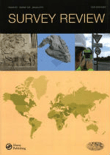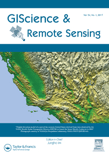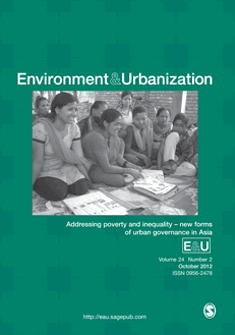
Journal of Geovisualization and Spatial Analysis
Scope & Guideline
Advancing Knowledge Through Spatial Insights
Introduction
Aims and Scopes
- Geospatial Data Analysis and Modeling:
The journal emphasizes the application of advanced analytical techniques and modeling approaches to understand spatial phenomena, including land use changes, environmental impacts, and urban dynamics. - Remote Sensing Applications:
A core area of research involves utilizing remote sensing technologies to monitor and assess environmental changes, urbanization effects, and natural resource management. - Machine Learning in Geovisualization:
The integration of machine learning algorithms in geospatial analysis is a focus area, particularly for tasks such as land cover classification, object detection, and predictive modeling. - Cultural and Social Implications of Geospatial Data:
The journal explores the socio-cultural dimensions of geospatial data, including studies on urban livability, cultural ecosystem services, and public health. - Sustainable Urban Development and Planning:
Research often addresses urban sustainability, green spaces, and the spatial dynamics of urban growth, emphasizing the importance of geospatial analysis in urban planning.
Trending and Emerging
- Application of Artificial Intelligence and Machine Learning:
There is a marked increase in the use of AI and machine learning techniques for geospatial data analysis, enhancing accuracy in classification tasks and predictive modeling. - Integration of Geospatial and Social Media Data:
Emerging research highlights the use of social media data for geospatial analysis, particularly in assessing cultural ecosystem services and urban dynamics, indicating a trend towards harnessing user-generated content. - Focus on Climate Change and Environmental Monitoring:
The journal increasingly addresses issues related to climate change, including studies on urban heat islands, land cover change impacts, and environmental risk assessments, reflecting a growing concern for sustainable development. - Urban Geospatial Intelligence and Smart Cities:
Research focusing on urban geospatial intelligence, smart city applications, and the role of geovisualization in urban planning is on the rise, showcasing the relevance of geospatial data in modern urban environments. - Health Geography and Pandemic Response:
The COVID-19 pandemic has spurred a significant increase in research addressing health geography, including the use of geospatial analysis for tracking virus spread and vaccination efforts, highlighting the journal's commitment to addressing pressing global health issues.
Declining or Waning
- Traditional GIS Applications:
While GIS remains a foundational tool, the focus on basic GIS applications without integration of advanced technologies or innovative methodologies is declining. There is a noticeable shift towards more complex analyses that incorporate machine learning and big data. - Static Mapping Techniques:
The use of static mapping techniques is decreasing as dynamic and interactive visualization methods gain traction. Researchers are increasingly favoring approaches that allow for real-time data interaction and visualization. - Regional Studies with Limited Scope:
Research that focuses narrowly on specific regional studies without broader applicability or comparative analysis is waning. The journal is moving towards studies that offer insights with potential for global applicability or inter-regional comparisons.
Similar Journals

Geomatik
Fostering collaboration for impactful geomatic research.Geomatik is a pioneering open-access journal dedicated to advancing the field of geomatics, encompassing disciplines such as geospatial data analysis, remote sensing, and geographic information systems. Founded in 2016 by the esteemed Geomatik Journal publisher, this peer-reviewed platform aims to disseminate high-quality research and innovative methodologies to a global audience. With its E-ISSN 2564-6761, Geomatik facilitates accessibility to cutting-edge studies that address vital challenges in environment monitoring, urban planning, and spatial data management. The journal not only encourages collaboration among researchers and practitioners but also serves as an essential resource for students seeking to deepen their understanding of geomatic sciences. Its commitment to open access fosters scholarly exchange and enhances visibility for authors, contributing to significant advancements within the geomatics community.

South African Journal of Geomatics
Innovating Mapping Technologies for Global ImpactSouth African Journal of Geomatics is a pivotal platform dedicated to the advancement of geomatics, focusing on the dynamic intersection of geographic information science, surveying, and mapping technologies. Published by CONSAS CONFERENCE, the journal serves as a crucial resource for researchers, professionals, and students in the geomatics field, providing insightful, peer-reviewed articles that explore contemporary challenges and innovations. Operating under an open-access model, the journal ensures the wide dissemination of knowledge, promoting collaboration and scholarly exchange among the global geomatics community. With a commitment to enhancing the visibility of significant research and fostering academic discourse, the South African Journal of Geomatics plays a vital role in contributing to the development of this essential discipline in South Africa and beyond.

SURVEY REVIEW
Exploring Innovations in Earth and Planetary SciencesSURVEY REVIEW is a distinguished journal published by Taylor & Francis Ltd, focusing on a diverse range of disciplines including Civil and Structural Engineering, Computers in Earth Sciences, and Earth and Planetary Sciences. With an ISSN of 0039-6265 and an E-ISSN of 1752-2706, this journal has been a vital resource for scholarly communication since its inception in 1963. Positioned within the Q2 and Q3 quartile categories according to the latest rankings, it is recognized for its significant contributions to advancing knowledge in multiple fields, specifically holding a rank of 64/159 in Earth and Planetary Sciences and 32/73 in Computers in Earth Sciences. Researchers, professionals, and students benefit from its critical insights into complex engineering and scientific challenges. Although SURVEY REVIEW is not open access, it remains a highly cited journal, making it an essential avenue for disseminating pivotal findings that impact both academia and industry practices.

African Geographical Review
Championing Research that Shapes Africa's Geographic FutureAfrican Geographical Review is a pivotal academic journal published by Routledge Journals, Taylor & Francis Ltd, whose mission is to advance knowledge and understanding of geographical dynamics across the African continent. With an ISSN of 1937-6812 and an E-ISSN of 2163-2642, this journal consistently delivers high-quality research, showcasing innovative perspectives and interdisciplinary approaches within the fields of Earth-Surface Processes and Geography, Planning and Development. Recognized in 2023 with a Q2 ranking in these categories, it ranks #231 out of 821 in Social Sciences and #63 out of 179 in Earth and Planetary Sciences according to Scopus metrics, reflecting its substantial impact and relevance. Featuring research that spans various geographic themes, the journal not only champions academic inquiry but also fosters a deeper understanding of spatial and environmental challenges unique to Africa. Engaging with a diverse audience of researchers, professionals, and students, the African Geographical Review serves as an indispensable resource for those committed to enhancing geographic scholarship and informing sustainable development practices across the continent.

GIScience & Remote Sensing
Transforming Data into Earthly DiscoveriesGIScience & Remote Sensing, published by Taylor & Francis Ltd, stands as a leading journal in the realm of Earth and Planetary Sciences, holding a prestigious Q1 ranking. Since its transition to Open Access in 2022, the journal has significantly broadened its reach, enabling researchers, professionals, and students across the globe to disseminate and access cutting-edge research related to geographic information science and remote sensing technologies. With a focus on publishing high-quality, peer-reviewed articles that contribute to the understanding of the Earth’s processes, environments, and interactions, this journal not only supports advancements in scientific knowledge but also fosters interdisciplinary collaboration. Based in the United Kingdom, GIScience & Remote Sensing continues to pave the way for innovative methodologies and applications, solidifying its vital role within the scientific community.

Geographia Technica
Fostering Excellence in Interdisciplinary ResearchGeographia Technica is an esteemed academic journal published by GEOGRAPHIA TECHNICA ASSOCIATION - GT Assoc in Romania, serving as a vital platform for the dissemination of cutting-edge research in the interdisciplinary fields of geography, planning, and earth sciences. Since its inception in 2009 and continuing through to 2024, the journal has established itself as a respected source of knowledge, reflected in its classification within the Q3 category across significant fields such as Computers in Earth Sciences, Earth-Surface Processes, and Geography, Planning and Development. With the ambition to enhance the understanding of socio-environmental interactions and technological applications in these areas, Geographia Technica invites scholars and practitioners to contribute original research that pushes the boundaries of current knowledge. Although currently not listed as open access, the journal's engaging content ensures it remains a valuable resource for researchers, professionals, and students keen on advancing their expertise in these dynamic disciplines.

GEOGRAFICKY CASOPIS-Geographical Journal
Elevating geographic research through interdisciplinary collaboration.GEOGRAFICKY CASOPIS-Geographical Journal is a prestigious publication dedicated to advancing knowledge in the fields of geography and earth sciences, published by the SLOVAK ACADEMY OF SCIENCES, INSTITUTE OF GEOGRAPHY. With a rich history dating back to its inception in 1976, the journal serves as a vital forum for researchers and professionals to disseminate their findings across a range of topics including earth-surface processes, geography, planning, development, and geology. Notably, it maintains a respectable Q3 category ranking across these disciplines as of 2023, indicating its contribution to relevant academic discourse. The journal is indexed under critical databases and engages a global audience, making it an essential resource for scholars seeking to stay informed about contemporary issues and advancements in geography. Although currently not an open-access journal, it emphasizes the sharing of significant research findings and encourages submissions from various geographical contexts to enrich the scientific community. Geographical Journal's commitment to fostering interdisciplinary dialogue ensures its relevance and importance in shaping the future of geographical research.

Geo-Spatial Information Science
Connecting Researchers and Practitioners through Geospatial InsightsGeo-Spatial Information Science, published by TAYLOR & FRANCIS LTD, is a premier open-access journal that has been at the forefront of disseminating cutting-edge research since its inception in 1998. With an ISSN of 1009-5020 and an E-ISSN of 1993-5153, this journal plays a pivotal role in the fields of Computers in Earth Sciences and Geography, Planning and Development, achieving a prestigious Q1 ranking in both categories as of 2023. Its exemplary Scopus rankings highlight its relevance within the social sciences and earth sciences, placing it among the top echelons of its field, with a 95th and 93rd percentile respectively. The journal aims to bridge the gap between innovative geospatial technologies and their applications in real-world scenarios, fostering interdisciplinary collaboration and advancing the global understanding of spatial data analysis. Based in the United Kingdom, Geo-Spatial Information Science invites researchers, professionals, and students to contribute and access research that shapes the future of geo-spatial sciences, all while adhering to open access principles that ensure broad dissemination and engagement with the broader academic community.

Advances in Geodesy and Geoinformation
Unlocking Geospatial Insights for a Global AudienceAdvances in Geodesy and Geoinformation is a pioneering journal published by the Polish Academy of Sciences, dedicated to the dynamic fields of geodesy and geoinformation. With an ISSN of 2720-7242 and an E-ISSN of 2720-7242, it offers an open-access platform since 2022, making cutting-edge research readily accessible to a global audience. The journal aims to foster the dissemination of innovative methodologies, technologies, and applications in the realms of geospatial data and earth sciences. Researchers, professionals, and students alike can benefit from the high-quality articles that contribute to advancing knowledge in this critical area, bridging theoretical insights and practical solutions. Situated in the heart of Poland, at PL Defilad 1, Warszawa, the journal not only reflects the nation's academic rigor but also positions itself as a crucial hub for international collaboration and knowledge exchange in geodesy and geoinformation.

ENVIRONMENT AND URBANIZATION
Transforming urban challenges into sustainable opportunities.Environment and Urbanization is a leading interdisciplinary journal published by SAGE Publications Ltd, dedicated to advancing knowledge in the fields of Environmental Science and Urban Studies. With a strong focus on the interactions between urban environments and ecological systems, this journal has established itself as a pivotal resource for researchers, professionals, and students interested in sustainable urban development and environmental management. Since its inception in 1989, Environment and Urbanization has continually provided high-quality, peer-reviewed articles that foster a deeper understanding of contemporary urban challenges, making it a highly cited publication with an impressive impact factor. As evidenced by its Q1 ranking in both Environmental Science (miscellaneous) and Urban Studies for 2023, the journal stands at the forefront of research, boasting notable Scopus rankings in its fields. By remaining committed to publishing cutting-edge research, the journal aims to influence policy and practice across the globe, ultimately aiding in the creation of more resilient and livable urban areas.